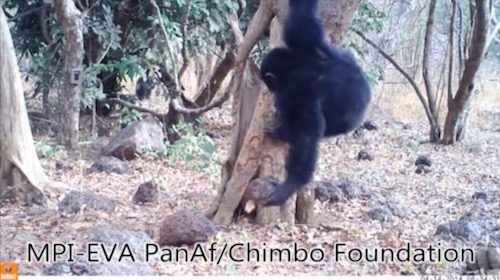 Culture & Ethics
Culture & Ethics
 Evolution
Evolution
 Faith & Science
Faith & Science
Now Chimps Practice "Sacred Rituals"

In the drive to eliminate the distinction between people and animals, chimps in particular, I should have guessed it would come this. Here’s a scientist who claims that chimps practice “sacred rituals” of their own devising. They not only use tools, they have something like religion!
Click on the image above to watch the video and see if it reminds you of your most recent visit to a church or synagogue. Chimps are caught on camera repeatedly rushing at a tree and banging a rock against it. At The Conversation, Laura Kehoe of Berlin’s Humboldt University writes (“Mysterious chimpanzee behaviour may be evidence of ‘sacred’ rituals“):
I spent many months in the field, along with many other researchers, trying to figure out what these chimps are up to. So far we have two main theories. The behaviour could be part of a male display, where the loud bang made when a rock hits a hollow tree adds to the impressive nature of a display. This could be especially likely in areas where there are not many trees with large roots that chimps would normally drum on with their powerful hands and feet. If some trees produce an impressive bang, this could accompany or replace feet drumming in a display and trees with particularly good acoustics could become popular spots for revisits.
On the other hand, it could be more symbolic than that — and more reminiscent of our own past. Marking pathways and territories with signposts such as piles of rocks is an important step in human history. Figuring out where chimps’ territories are in relation to rock throwing sites could give us insights into whether this is the case here.
Even more intriguing than this, maybe we found the first evidence of chimpanzees creating a kind of shrine that could indicate sacred trees. Indigenous West African people have stone collections at “sacred” trees and such man-made stone collections are commonly observed across the world and look eerily similar to what we have discovered here.
That’s a lot of hypotheticals. It could be “symbolic,” the tree could be “sacred,” it could be “reminiscent of our own past,” granting a peek into the evolution of human sacred practices. I can think of instances where throwing or leaving rocks features in ritual or custom of religions today and of the past. Muslims practice the “Stoning of the Devil” rite as part of the Hajj. Jews leave pebbles on grave markers as a sign of having visited the spot, indicating that a loved one has not been forgotten. Throwing stones at an idol as part of ancient Roman worship is also attested. By the same token, “sacred trees” are well known from pagan worship.
It’s an intriguing parallel, but…come on. A symbol like this would obviously attest to abstract thought — that’s what a symbol is — and chimps and other animals don’t do that. I can also think of activities shared by humans and animals that appear in human ritual — eating, drinking, and sex are three examples. But chimps doing those things are not practicing sacred rituals.
That the business with hurling oneself and a rock at a tree is a form of display, or play, seems the obvious interpretation. A better parallel might be with human sports, many of which involve running and aiming some rock-sized object at a target. We do know that playing is an activity shared by humans and a range of other creatures. No doubt there’s something primal in throwing a rock or a ball, which probably gives sports some of their enjoyment.
Why then highlight a tenuous link with “ritual” if the intention is not to affirm the myth that human are hardly distinguishable from animals, including in our most sacred beliefs? Myth-making…that’s another things that humans do, and chimpanzees do not.
